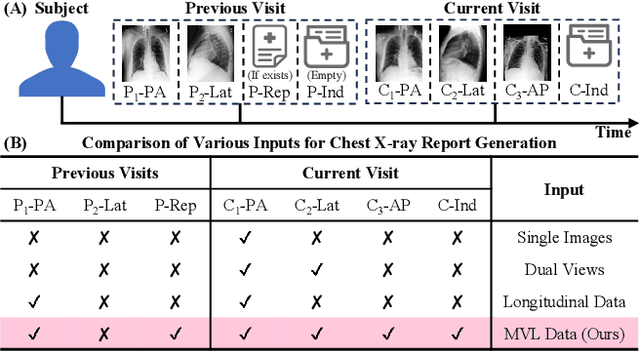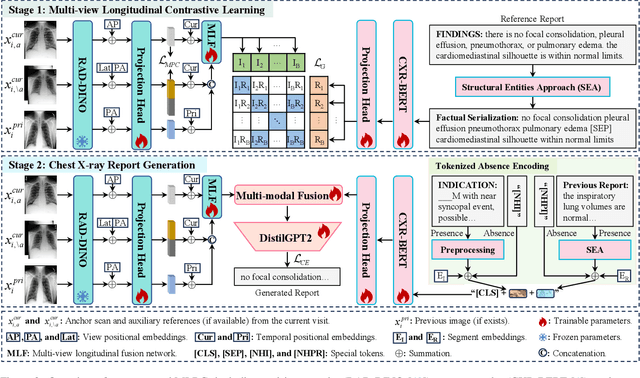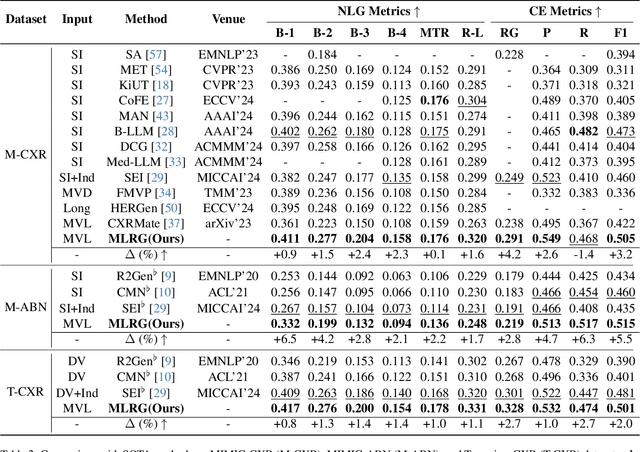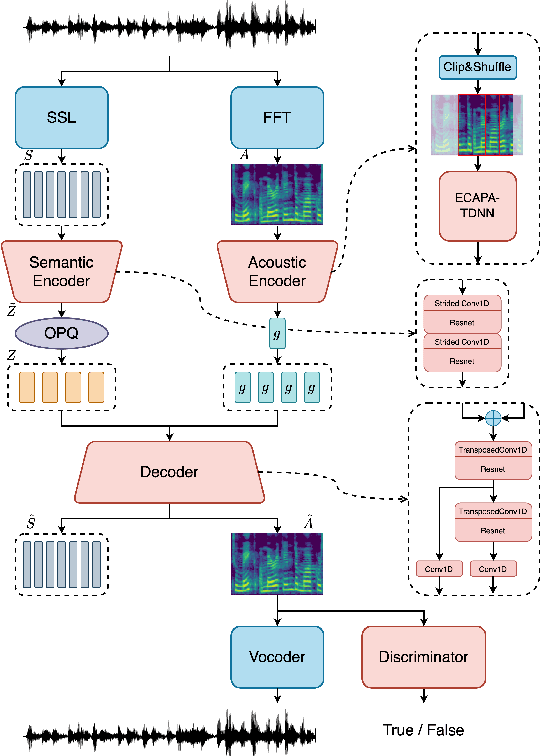Kun Xie
PriorRG: Prior-Guided Contrastive Pre-training and Coarse-to-Fine Decoding for Chest X-ray Report Generation
Aug 07, 2025



Abstract:Chest X-ray report generation aims to reduce radiologists' workload by automatically producing high-quality preliminary reports. A critical yet underexplored aspect of this task is the effective use of patient-specific prior knowledge -- including clinical context (e.g., symptoms, medical history) and the most recent prior image -- which radiologists routinely rely on for diagnostic reasoning. Most existing methods generate reports from single images, neglecting this essential prior information and thus failing to capture diagnostic intent or disease progression. To bridge this gap, we propose PriorRG, a novel chest X-ray report generation framework that emulates real-world clinical workflows via a two-stage training pipeline. In Stage 1, we introduce a prior-guided contrastive pre-training scheme that leverages clinical context to guide spatiotemporal feature extraction, allowing the model to align more closely with the intrinsic spatiotemporal semantics in radiology reports. In Stage 2, we present a prior-aware coarse-to-fine decoding for report generation that progressively integrates patient-specific prior knowledge with the vision encoder's hidden states. This decoding allows the model to align with diagnostic focus and track disease progression, thereby enhancing the clinical accuracy and fluency of the generated reports. Extensive experiments on MIMIC-CXR and MIMIC-ABN datasets demonstrate that PriorRG outperforms state-of-the-art methods, achieving a 3.6% BLEU-4 and 3.8% F1 score improvement on MIMIC-CXR, and a 5.9% BLEU-1 gain on MIMIC-ABN. Code and checkpoints will be released upon acceptance.
Chi-Square Wavelet Graph Neural Networks for Heterogeneous Graph Anomaly Detection
May 25, 2025Abstract:Graph Anomaly Detection (GAD) in heterogeneous networks presents unique challenges due to node and edge heterogeneity. Existing Graph Neural Network (GNN) methods primarily focus on homogeneous GAD and thus fail to address three key issues: (C1) Capturing abnormal signal and rich semantics across diverse meta-paths; (C2) Retaining high-frequency content in HIN dimension alignment; and (C3) Learning effectively from difficult anomaly samples with class imbalance. To overcome these, we propose ChiGAD, a spectral GNN framework based on a novel Chi-Square filter, inspired by the wavelet effectiveness in diverse domains. Specifically, ChiGAD consists of: (1) Multi-Graph Chi-Square Filter, which captures anomalous information via applying dedicated Chi-Square filters to each meta-path graph; (2) Interactive Meta-Graph Convolution, which aligns features while preserving high-frequency information and incorporates heterogeneous messages by a unified Chi-Square Filter; and (3) Contribution-Informed Cross-Entropy Loss, which prioritizes difficult anomalies to address class imbalance. Extensive experiments on public and industrial datasets show that ChiGAD outperforms state-of-the-art models on multiple metrics. Additionally, its homogeneous variant, ChiGNN, excels on seven GAD datasets, validating the effectiveness of Chi-Square filters. Our code is available at https://github.com/HsipingLi/ChiGAD.
FireRedTTS-1S: An Upgraded Streamable Foundation Text-to-Speech System
Mar 26, 2025Abstract:In this work, we propose a high-quality streaming foundation text-to-speech system, FireRedTTS-1S, upgraded from the streamable version of FireRedTTS. FireRedTTS-1S achieves streaming generation via two steps: text-to-semantic decoding and semantic-to-acoustic decoding. In text-to-semantic decoding, a semantic-aware speech tokenizer converts the speech signal into semantic tokens, which can be synthesized from the text via a semantic language model in an auto-regressive manner. Meanwhile, the semantic-to-acoustic decoding module simultaneously translates generated semantic tokens into the speech signal in a streaming way via a super-resolution causal audio codec and a multi-stream acoustic language model. This design enables us to produce high-quality speech audio in zero-shot settings while presenting a real-time generation process with low latency under 150ms. In experiments on zero-shot voice cloning, the objective results validate FireRedTTS-1S as a high-quality foundation model with comparable intelligibility and speaker similarity over industrial baseline systems. Furthermore, the subjective score of FireRedTTS-1S highlights its impressive synthesis performance, achieving comparable quality to the ground-truth recordings. These results validate FireRedTTS-1S as a high-quality streaming foundation TTS system.
Enhanced Contrastive Learning with Multi-view Longitudinal Data for Chest X-ray Report Generation
Feb 27, 2025



Abstract:Automated radiology report generation offers an effective solution to alleviate radiologists' workload. However, most existing methods focus primarily on single or fixed-view images to model current disease conditions, which limits diagnostic accuracy and overlooks disease progression. Although some approaches utilize longitudinal data to track disease progression, they still rely on single images to analyze current visits. To address these issues, we propose enhanced contrastive learning with Multi-view Longitudinal data to facilitate chest X-ray Report Generation, named MLRG. Specifically, we introduce a multi-view longitudinal contrastive learning method that integrates spatial information from current multi-view images and temporal information from longitudinal data. This method also utilizes the inherent spatiotemporal information of radiology reports to supervise the pre-training of visual and textual representations. Subsequently, we present a tokenized absence encoding technique to flexibly handle missing patient-specific prior knowledge, allowing the model to produce more accurate radiology reports based on available prior knowledge. Extensive experiments on MIMIC-CXR, MIMIC-ABN, and Two-view CXR datasets demonstrate that our MLRG outperforms recent state-of-the-art methods, achieving a 2.3% BLEU-4 improvement on MIMIC-CXR, a 5.5% F1 score improvement on MIMIC-ABN, and a 2.7% F1 RadGraph improvement on Two-view CXR.
MCL: Multi-view Enhanced Contrastive Learning for Chest X-ray Report Generation
Nov 15, 2024



Abstract:Radiology reports are crucial for planning treatment strategies and enhancing doctor-patient communication, yet manually writing these reports is burdensome for radiologists. While automatic report generation offers a solution, existing methods often rely on single-view radiographs, limiting diagnostic accuracy. To address this problem, we propose MCL, a Multi-view enhanced Contrastive Learning method for chest X-ray report generation. Specifically, we first introduce multi-view enhanced contrastive learning for visual representation by maximizing agreements between multi-view radiographs and their corresponding report. Subsequently, to fully exploit patient-specific indications (e.g., patient's symptoms) for report generation, we add a transitional ``bridge" for missing indications to reduce embedding space discrepancies caused by their presence or absence. Additionally, we construct Multi-view CXR and Two-view CXR datasets from public sources to support research on multi-view report generation. Our proposed MCL surpasses recent state-of-the-art methods across multiple datasets, achieving a 5.0% F1 RadGraph improvement on MIMIC-CXR, a 7.3% BLEU-1 improvement on MIMIC-ABN, a 3.1% BLEU-4 improvement on Multi-view CXR, and an 8.2% F1 CheXbert improvement on Two-view CXR.
Drone Data Analytics for Measuring Traffic Metrics at Intersections in High-Density Areas
Nov 04, 2024Abstract:This study employed over 100 hours of high-altitude drone video data from eight intersections in Hohhot to generate a unique and extensive dataset encompassing high-density urban road intersections in China. This research has enhanced the YOLOUAV model to enable precise target recognition on unmanned aerial vehicle (UAV) datasets. An automated calibration algorithm is presented to create a functional dataset in high-density traffic flows, which saves human and material resources. This algorithm can capture up to 200 vehicles per frame while accurately tracking over 1 million road users, including cars, buses, and trucks. Moreover, the dataset has recorded over 50,000 complete lane changes. It is the largest publicly available road user trajectories in high-density urban intersections. Furthermore, this paper updates speed and acceleration algorithms based on UAV elevation and implements a UAV offset correction algorithm. A case study demonstrates the usefulness of the proposed methods, showing essential parameters to evaluate intersections and traffic conditions in traffic engineering. The model can track more than 200 vehicles of different types simultaneously in highly dense traffic on an urban intersection in Hohhot, generating heatmaps based on spatial-temporal traffic flow data and locating traffic conflicts by conducting lane change analysis and surrogate measures. With the diverse data and high accuracy of results, this study aims to advance research and development of UAVs in transportation significantly. The High-Density Intersection Dataset is available for download at https://github.com/Qpu523/High-density-Intersection-Dataset.
FireRedTTS: A Foundation Text-To-Speech Framework for Industry-Level Generative Speech Applications
Sep 05, 2024



Abstract:This work proposes FireRedTTS, a foundation text-to-speech framework, to meet the growing demands for personalized and diverse generative speech applications. The framework comprises three parts: data processing, foundation system, and downstream applications. First, we comprehensively present our data processing pipeline, which transforms massive raw audio into a large-scale high-quality TTS dataset with rich annotations and a wide coverage of content, speaking style, and timbre. Then, we propose a language-model-based foundation TTS system. The speech signal is compressed into discrete semantic tokens via a semantic-aware speech tokenizer, and can be generated by a language model from the prompt text and audio. Then, a two-stage waveform generator is proposed to decode them to the high-fidelity waveform. We present two applications of this system: voice cloning for dubbing and human-like speech generation for chatbots. The experimental results demonstrate the solid in-context learning capability of FireRedTTS, which can stably synthesize high-quality speech consistent with the prompt text and audio. For dubbing, FireRedTTS can clone target voices in a zero-shot way for the UGC scenario and adapt to studio-level expressive voice characters in the PUGC scenario via few-shot fine-tuning with 1-hour recording. Moreover, FireRedTTS achieves controllable human-like speech generation in a casual style with paralinguistic behaviors and emotions via instruction tuning, to better serve spoken chatbots.
SoCodec: A Semantic-Ordered Multi-Stream Speech Codec for Efficient Language Model Based Text-to-Speech Synthesis
Sep 02, 2024



Abstract:The long speech sequence has been troubling language models (LM) based TTS approaches in terms of modeling complexity and efficiency. This work proposes SoCodec, a semantic-ordered multi-stream speech codec, to address this issue. It compresses speech into a shorter, multi-stream discrete semantic sequence with multiple tokens at each frame. Meanwhile, the ordered product quantization is proposed to constrain this sequence into an ordered representation. It can be applied with a multi-stream delayed LM to achieve better autoregressive generation along both time and stream axes in TTS. The experimental result strongly demonstrates the effectiveness of the proposed approach, achieving superior performance over baseline systems even if compressing the frameshift of speech from 20ms to 240ms (12x). The ablation studies further validate the importance of learning the proposed ordered multi-stream semantic representation in pursuing shorter speech sequences for efficient LM-based TTS.
KPG: Key Propagation Graph Generator for Rumor Detection based on Reinforcement Learning
May 21, 2024Abstract:The proliferation of rumors on social media platforms during significant events, such as the US elections and the COVID-19 pandemic, has a profound impact on social stability and public health. Existing approaches for rumor detection primarily rely on propagation graphs to enhance model effectiveness. However, the presence of noisy and irrelevant structures during the propagation process limits the efficacy of these approaches. To tackle this issue, techniques such as weight adjustment and data augmentation have been proposed. However, these techniques heavily depend on rich original propagation structures, thus hindering performance when dealing with rumors that lack sufficient propagation information in the early propagation stages. In this paper, we propose Key Propagation Graph Generator (KPG), a novel reinforcement learning-based rumor detection framework that generates contextually coherent and informative propagation patterns for events with insufficient topology information, while also identifies indicative substructures for events with redundant and noisy propagation structures. KPG consists of two key components: the Candidate Response Generator (CRG) and the Ending Node Selector (ENS). CRG learns the latent distribution from refined propagation patterns, filtering out noise and generating new candidates for ENS. Simultaneously, ENS identifies the most influential substructures within propagation graphs and generates training data for CRG. Moreover, we introduce an end-to-end framework that utilizes rewards to guide the entire training process via a pre-trained graph neural network. Extensive experiments conducted on four datasets demonstrate the superiority of our KPG compared to the state-of-the-art approaches.
Factual Serialization Enhancement: A Key Innovation for Chest X-ray Report Generation
May 15, 2024Abstract:The automation of writing imaging reports is a valuable tool for alleviating the workload of radiologists. Crucial steps in this process involve the cross-modal alignment between medical images and reports, as well as the retrieval of similar historical cases. However, the presence of presentation-style vocabulary (e.g., sentence structure and grammar) in reports poses challenges for cross-modal alignment. Additionally, existing methods for similar historical cases retrieval face suboptimal performance owing to the modal gap issue. In response, this paper introduces a novel method, named Factual Serialization Enhancement (FSE), for chest X-ray report generation. FSE begins with the structural entities approach to eliminate presentation-style vocabulary in reports, providing specific input for our model. Then, uni-modal features are learned through cross-modal alignment between images and factual serialization in reports. Subsequently, we present a novel approach to retrieve similar historical cases from the training set, leveraging aligned image features. These features implicitly preserve semantic similarity with their corresponding reference reports, enabling us to calculate similarity solely among aligned features. This effectively eliminates the modal gap issue for knowledge retrieval without the requirement for disease labels. Finally, the cross-modal fusion network is employed to query valuable information from these cases, enriching image features and aiding the text decoder in generating high-quality reports. Experiments on MIMIC-CXR and IU X-ray datasets from both specific and general scenarios demonstrate the superiority of FSE over state-of-the-art approaches in both natural language generation and clinical efficacy metrics.
 Add to Chrome
Add to Chrome Add to Firefox
Add to Firefox Add to Edge
Add to Edge